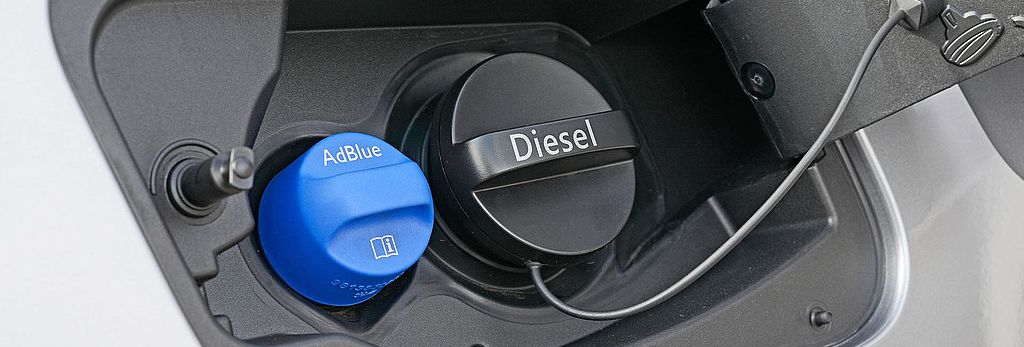
AdBlue
What is AdBlue?
AdBlue is the trade name of an aqueous urea solution consisting of 32.5 mass % pure urea by weight and demineralized water. This colorless, odorless, non-toxic water-urea mixture is used to reduce the nitrogen oxide (NOx) emissions produced by diesel engines in vehicles.
AdBlue is a registered trademark of the German Association of the Automotive Industry (VDA). The water-urea mixture is defined as AUS 32 (aqueous urea solution) in the international ISO 22241 standard (comparable with the German standard DIN 70070) and is also known as Arla 32 in South America. In North America, the urea solution is sold as diesel exhaust fluid (DEF). Skin contact with the liquid, which is not classified as a hazardous substance, should be avoided in principle, but is not dangerous.
AdBlue and SCR catalytic converters
Nitrogen oxide emissions can only be reduced with AdBlue in conjunction with an SCR catalytic converter (SCR = selective catalytic reduction). A high-pressure dosing pump is used to inject the aqueous urea solution into the exhaust pipeline before the SCR catalytic converter. Here, AdBlue is converted into ammonia via an intermediate step. Only once the ammonia has been released can the nitrogen oxides react – in an SCR catalytic converter coated with vanadium, tungsten or titanium oxide, and at temperatures of above approx. 170°C – to form nitrogen and water. The optimum volume of AdBlue for this reaction depends on the engine’s nitric oxide emissions, which change depending on its speed of rotation and the required torque. In practice, the AdBlue quantities are dosed based on the previously determined engine map.
Nitrogen oxide emissions can be reduced by up to 90% using SCR technology. The AdBlue consumed in the process is between 2% and 8% of the diesel consumption, and is specified by the VDA at an average of approximately 1.5 liters per 1000 kilometers. By optimizing engine management, trucks can reduce their fuel consumption by up to 6% using AdBlue.
AdBlue requires an additional tank
The aqueous urea solution requires an additional tank, which must be made of plastic or stainless steel, because AdBlue is corrosive to most metals. While an AdBlue tank holds around 17 liters in most passenger cars, they are significantly larger for trucks. As AdBlue starts to freeze at about -11°C, tanks are equipped with an additional heater for use in regions subject to severe frost.
How is AdBlue produced?
AdBlue is produced from a mixture of natural gas and nitrogen, from which ammonia is initially produced using the Haber-Bosch process. Carbon dioxide is then added to the ammonia, a toxic and highly irritant gas, to produce a liquid urea melt in the urea synthesis reaction. In the last production step, demineralized water is added to bring it to the right percentage. In-house production using solid urea is not recommended, because exceedance of the required degree of purity can lead to damage to the SCR catalytic converter.
AdBlue infrastructure
As the urea-water solution is produced by approximately 150 manufacturers worldwide, its availability is ensured even if sales volumes increase in the future. While AdBlue and SCR catalytic converters have long been used for trucks to ensure compliance with Euro 4 and Euro 5 emission standards, the technology is now also increasingly being used in cars as well. However, the technology generates additional costs.
A VDA survey estimates that a total of around 20 million diesel vehicles with AdBlue technology will be on the road in Europe by 2020. Therefore, AdBlue pumps for passenger cars are currently being built at service stations across Europe.
AdBlue is traded by Mabanaft group companies: In the Retail business, it is mainly sold by Petronord companies as well as OIL! Tankstellen.
Status: December 2016
All information subject to change. Errors and omissions excepted.

